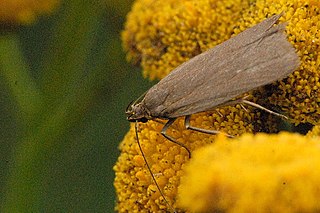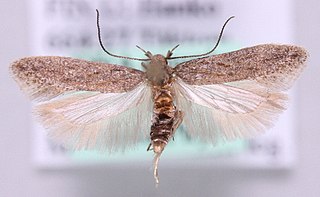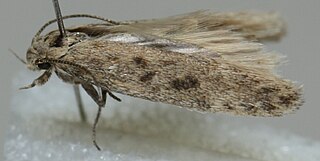
Agrotis segetum, sometimes known as the turnip moth, is a moth of the family Noctuidae. The species was first described by Michael Denis and Ignaz Schiffermüller in 1775. It is a common European species and it is found in Africa and across Eurasia except for the northernmost parts.

Phthorimaea operculella, also known as the potato tuber moth or tobacco splitworm, is a moth of the family Gelechiidae. It is an oligophagous insect that feeds on the plant family Solanaceae and is especially known for being a major pest of potato crops. Currently farmers utilize insecticides, parasites, and sprinkler irrigation in order to prevent P. operculella from infesting their croplands.
Chaliniastis is a genus of moth in the family Gelechiidae. It contains the species Chaliniastis astrapaea, which is found in Australia, where it has been recorded from Queensland and New South Wales.

Anarsia molybdota is a species of moth of the family Gelechiidae. It is found in Australia, where it has been recorded from Queensland, Victoria, New South Wales, the Australian Capital Territory, South Australia and Western Australia.

Scrobipalpa acuminatella is a moth of the family Gelechiidae. It is found in most of Europe, as well as Turkey, southern Siberia, Central Asia and China (Anhui). It was recently reported from Canada, with records from Ontario and Québec.

Ctenoplusia limbirena, the Scar Bank gem, or silver U-tail, is a moth of the family Noctuidae. It is found in south-western Europe, Africa, the Canary Islands, Arabia, the southern Himalayas, India, Sri Lanka, Indochina to south-eastern China, Taiwan, Sulawesi, Bali and Timor. In New Zealand, it has been established since 2011.

Scrobipalpa nitentella, the common sea groundling, is a moth of the family Gelechiidae. It is found in most of Europe, North Africa (Tunisia), Turkey, Afghanistan, Kazakhstan, China, Mongolia and Siberia (Transbaikalia).

Scrobipalpa obsoletella, the summer groundling, is a moth of the family Gelechiidae. It is found in most of Europe, Turkey, the Caucasus, from Iran to Asian Russia (Transbaikal) and Mongolia. It has also been recorded from New Zealand, South Africa and North America, where it is probably an introduced species. The habitat consists of coastal salt marshes and sandy beaches.

Scrobipalpa samadensis, the buck's-horn groundling, is a moth of the family Gelechiidae. It is found in most of Europe and Russia.
Scrobipalpa ergasima is a moth of the family Gelechiidae. Edward Meyrick first used the scientific name in 1916. It is found in the Mediterranean Region and on the Canary Islands. Outside of Europe, it is found in Egypt, Saudi Arabia, the Democratic Republic of the Congo, Namibia, South Africa, Sudan, Australia, India, Indonesia, Myanmar and Pakistan.
Ardozyga anthracina is a species of moth in the family Gelechiidae. It was described by Edward Meyrick in 1904. It is found in Australia, where it has been recorded from New South Wales.
Ardozyga crypsibatis is a species of moth in the family Gelechiidae. It was described by Edward Meyrick in 1904. It is found in Australia, where it has been recorded from Tasmania, New South Wales and South Australia.
Ardozyga frugalis is a species of moth in the family Gelechiidae. It was described by Edward Meyrick in 1904. It is found in Australia, where it has been recorded from New South Wales and Western Australia.
Ardozyga stratifera, the striped ardozyga moth, is a species of moth in the family Gelechiidae. It was described by Edward Meyrick in 1904. It is found in Australia, where it has been recorded from Queensland, New South Wales, Victoria, Tasmania, South Australia and Western Australia.
Anisoplaca bathropis is a species of moth in the family Gelechiidae. It was described by Edward Meyrick in 1904. It is found in Australia, where it has been recorded from New South Wales and South Australia.
Scrobipalpa erichi is a moth in the family Gelechiidae. It was described by Povolný in 1964. It is found in Austria, Slovakia, the Czech Republic, Hungary, Romania, North Macedonia, Moldova, Ukraine, the Middle East, China, Iran, and Mongolia.
Scrobipalpa pyrrhanthes is a moth in the family Gelechiidae. It was described by Edward Meyrick in 1904. It is found in Australia, where it has been recorded form New South Wales, Western Australia, and Victoria.
Scrobipalpa leucocephala is a moth in the family Gelechiidae. It was described by Oswald Bertram Lower in 1893. It is found in Australia, where it has been recorded form Queensland, New South Wales and South Australia.
Scrobipalpa nonyma is a moth in the family Gelechiidae. It was described by Turner in 1919. It is found in Australia, where it has been recorded from Victoria.

Aproaerema simplexella, the soybean moth, is a moth in the family Gelechiidae. It was described by Francis Walker in 1864. It is found in India, China, Australia, Norfolk Island and New Zealand. It is an invasive species in Africa, where it has since been recorded from the Democratic Republic of the Congo, Malawi, South Africa and Uganda.









